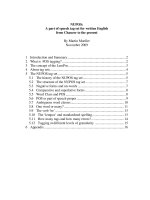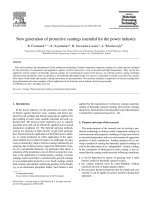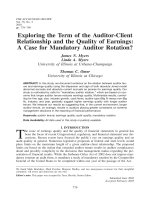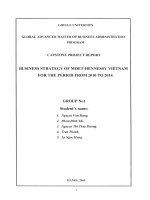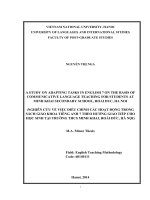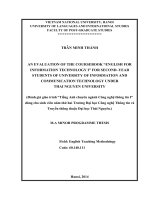Engineering of biodegradable scaffolds intended for liver tissue engineering
Bạn đang xem bản rút gọn của tài liệu. Xem và tải ngay bản đầy đủ của tài liệu tại đây (5.56 MB, 211 trang )
ENGINEERING
OF
BIODEGRADABLE
SCAFFOLDS
INTENDED
FOR
LIVER TISSUE ENGINEERING
WEN FENG
(M.S., National University of Singapore)
A THESIS SUBMITTED FOR THE DEGREE OF
DOCTOR OF PHILOSOPHY
DEPARTMENT OF MECHANICAL ENGINEERING
NATIONAL UNIVERSITY OF SINGAPORE
2007
Preface
PREFACE
This thesis is submitted for the degree of Doctor of Philosophy in the Department
of Mechanical Engineering at the National University of Singapore under the
supervision of Professor Swee Hin TEOH and Associate Professor Hanry Yu. No part
of this thesis has been submitted for other degree or diploma at other universities or
institutions. To the author’s best knowledge, all the work presented in this thesis is
original unless reference is made to other works. Parts of this thesis have been
presented or published in the following:
International Journal Publications
1. F Wen, S Chang, YC Toh, SH Teoh, H Yu. Development of poly(lactic-coglycolic acid)-collagen scaffolds for tissue engineering. Materials Science and
Engineering: C 2007; 27:285−292.
2. F Wen, S Chang, YC Toh, T Arooz, L Zhuo, SH Teoh, H Yu. Development of
dual-compartment perfusion bioreactor for serial co-culture of hepatocytes and
stellate cells in poly(lactic-co glycolic acid)-collagen scaffolds. Journal of
Biomedical Materials Research Part B: Applied Biomaterials 2007 (accepted).
3. Yanan Du, Rongbin Han, Sussanne Ng, Feng Wen, Thorsten Wohland, Hanry Yu.
A Novel Synthetic Sandwich Culture of 3D Hepatocyte Monolayer. Biomaterials
2007 (accepted).
4. F Wen, YM Khong, S Chang, SH Teoh, H Yu. Surface modification of bulk PCL
scaffolds with gamma irradiation. Advanced Materials 2007 (in progress).
5. Zhilian Yue, Feng Wen, Lihong Liu, Hanry Yu. Three dimensional, biopolymeric
hydrogels with interconnected macroporosity for soft tissue engineering.
Advanced Materials 2007 (in progress).
International Refereed Conference Papers
1. FL Chen, F Wen, DW Hutmacher, SH Teoh. Stiffness of Polycaprolactone
Influences Chondrocytes Proliferation. TESI 2003, Orlando, USA.
2. F Wen, SH Teoh. Relationship between Material Stiffness and Cell Adaptation in
Tissue Engineered Scaffolds. ICMAT2004, Singapore.
3. F Wen, S Chang, SH Teoh, H Yu. Preparation of Biocompatible Poly(lactic-coglycolic acid) Fibre Scaffolds for Rat Liver Cells Cultivation. ICMAT2005,
Singapore.
Page i
Preface
4. F Wen, YM Khong, YN Du, ZL Yue, K Iouri, SH Teoh, H Yu. Surface
Modification of Bulky Tissue Engineering Scaffold through Gamma Irradiation.
Keystone Symposia (Tissue Engineering and Development Biology) 2007, USA.
5. SH Lau, F Wen, H Yu, Fred Duewer, Hauyee Chang, Michael Feser, Wenbing Yun.
Virtual Non Invasive 3D Imaging of Biomaterials and Soft Tissue with a Novel
High Contrast CT, with Resolution from mm to sub 30 nm. ICMAT 2007,
Singapore.
Wen Feng
Singapore, July 2007
Page ii
Acknowledgements
ACKNOWLEDGEMENTS
I would like to express my deepest gratitude to my supervisors, Professor Teoh
Swee Hin and Associate Professor Hanry Yu, who have led me into this exciting
multidisciplinary research area of liver tissue engineering. They have tirelessly given
me great support and patience during my 5 years of academic pursuit in NUS,
Singapore.
My study could not be completed without the help from friends and colleagues
around me. My special thanks goes to Drs. Ong Lee Lee and Chia Ser Min for their
expertise in performing cell immunofluorescence staining; Drs. Ying Lei and Cen Lian
from the Department of Chemical Engineering for their guidance on bio-conjugation;
Drs. Zhu Lang and Yue Zhilian from the Institute of Bioengineering and
Nanotechnology (IBN) for their kind provision of cell lines and invaluable advice;
Miss Tse Kit Yan from the Data Storage Institute (DSI) and Mr. Wong How Kwong
from the Physics Department for doing the XPS analysis; Ms. Lai Mei Ying from the
Institute of Materials Research and Engineering (IMRE) for ToF-SIMS analysis; Miss
Yang Fang, Miss Xu Chengyu and Ms. Tan Phay Shing from the Division of
Bioengineering who trained me in cell culture skill and AFM technology.
I would like to thank all my colleagues at the Cell and Tissue Engineering
Laboratory (CTEL), Yong Loo Lin School of Medicine, especially Miss Khong Yuet
Mei who provided me with the intra-tissue perfusion system. I also would like to
thank all my colleagues at the Centre for Biomedical Materials Applications and
Technology (BIOMAT), Faculty of Engineering, National University of Singapore, for
their technical assistance and encouragement.
Page iii
Acknowledgements
Last but not least, I would like to thank my wife (Chen Lijuan) and my sons
(Yiming and Yiluan) who share my aspirations and passion throughout the duration of
my research. More importantly, I would like to thank both my Mom and Dad for
always pushing me to do the best that I could, but yet giving me room and space to
find my own footing.
Page iv
Summary
SUMMARY
Liver transplantation is currently the only established, viable treatment for
metabolic liver diseases. However, there is an acute shortage of donor organs, thereby
fuelling researches on liver tissue engineering — such as development of bioartificial
liver (BAL) devices or cell-based transplantation therapies.
Nonetheless, both
developments are still in “infancy to adolescence” stage as the most significant
challenge of successfully maintaining viable and functional hepatocytes outside of
native liver environment has not been overcome. Isolated hepatocytes start to spread
and proliferate under suboptimal culture conditions, losing most of the characteristic
differentiated hepatic functions within three to four days.
To circumvent this challenge, several tissue engineering approaches have been
advocated to modulate the culture parameters in a bid to mimic the microenvironments
in vivo. These approaches include:
(1) Culturing in three-dimensional organisation;
(2) Culturing on bioactive surfaces;
(3) Culturing under flow conditions; and
(4) Culturing with several types of supporting cells include liver-derived and
non-liver-derived cells.
In light of these approaches and through a combination of these approaches, we
proposed to develop a strategy — which entailed two different types of scaffolds,
unstructured versus structured — to maintain a mass of highly functional, viable
hepatocytes which can preserve their differentiated functions for long-term cultivation.
Page v
Summary
The first novel scaffold developed in this study was an unstructured one with a
three-dimensional architecture.
A 3D structure was being considered and
contemplated in this study because a 3D scaffold is capable of supporting a mass of
cells, thereby improving the functionality of BAL devices. Leveraging on successfully
surface-modified poly(lactic-co-glycolic acid) (PLGA) microfibres — through
hybridization and collagen conjugation, a hybrid scaffold consisting of randomblended, collagen-grafted PLGA microfibres and crosslinked collagen was developed.
Compared to collagen sponges per se, it was found that this novel hybrid scaffold had
improved physical and mechanical properties as well as higher cellular affinity.
Moreover, through a perfusion coculture experiment in a dual-chamber bioreactor, the
results showed that hepatocytes cocultured with hepatic stellate cells (HSC-T6) in this
hybrid scaffold exhibited enhanced differentiated functions (such as albumin secretion
and urea synthesis) versus the monoculture system where hepatocytes alone were
cultured.
The second novel scaffold entailed a well-defined, three-dimensional structure
which was exposed to an intra-tissue perfusion (ITP) system. Previous studies have
shown that cell behaviour was influenced by scaffold architecture. Thus, to the end of
evaluating the clinical applicability of this novel structured scaffold, it was critical that
positive and affirmative cell responses were elicited. Furthermore, the ITP system
requires microneedles to serve as delivery conduits and a scaffold with a
well-defined structure facilitates penetration by a microneedle array.
The second hybrid scaffold was developed via gamma-induced polymerisation of
collagen in three-dimensional, porous polycaprolactone (PCL) scaffold preformed by
fused deposition modelling technique (FDM). First, the surface of PCL scaffold was
uniformly grafted with poly (acrylic acid) by gamma induction in a hierarchical order,
Page vi
Summary
followed by collagen conjugation. Next, collagen-conjugated scaffold was immersed
in a collagen solution and subjected to gamma-induced polymerisation.
After
freeze-drying, a hybrid scaffold composed of aligned PCL microfibres and tortuous
collagen sponge embedded between microfibres was formed. Cell seeding experiment
revealed better cell adhesion affinity on the surface of this hybrid scaffold versus the
synthetic polymer scaffold.
As for the maintenance of differentiated functions
expressed by the hepatocyte culture in this PCL-collagen hybrid scaffold, it was
examined through a perfusion culture in an intra-tissue perfusion system where the
scaffold was penetrated with a microneedle array through defined interspaces of the
scaffold. The results indicated enhanced differentiated functions — such as albumin
secretion and urea synthesis — throughout the entire culture period.
In conclusion, two different hybrid scaffolds were successfully fabricated: an
unstructured one comprising random-blended, collagen-grafted PLGA microfibres and
crosslinked collagen (PLGA-collagen), versus a structured and well-defined one which
comprised collagen sponge and a collagen-grafted, three-dimensional scaffold
preformed by FDM with gamma-induced collagen polymerisation (PCL-collagen).
Nonetheless, both types of hybrid scaffolds exhibited superior physical and mechanical
properties than their individual counterparts, and their chemical and biological
characterisation illustrated better cellular affinity.
Taken together, the encouraging results obtained in this study highlighted the
optimistic applicability of these scaffolds for liver tissue engineering. It should be
mentioned that the facile and effective approaches rendered in this thesis successfully
synchronised natural and synthetic polymers, as well as perfusion-based hepatocyte
coculture with HSC-T6.
As such, the herein-developed scaffolds were able to
maintain a mass of highly functional, viable hepatocytes which could preserve their
Page vii
Summary
differentiated functions for long-term cultivation— thereby paving the way for
efficient development of BAL devices and cell-based tissue construct transplantation
therapies in the future.
Page viii
Table of Contents
TABLE OF CONTENTS
CHAPTER 1 INTRODUCTION
1.1
BACKGROUND .......................................................................................................................... 1-1
1.2
OBJECTIVES .............................................................................................................................. 1-6
1.3
SCOPE OF DISSERTAION ........................................................................................................... 1-8
Bibliography......................................................................................................................................... 1-9
CHAPTER 2 LITERATURE REVIEW
2.1
INTRODUCTION ......................................................................................................................... 2-1
2.2
LIVER AND LIVER FAILURE ...................................................................................................... 2-1
2.2.1
Liver anatomy................................................................................................................... 2-1
2.1.2
Liver cells ......................................................................................................................... 2-2
2.1.3
Liver functions.................................................................................................................. 2-4
2.1.4
Liver failure...................................................................................................................... 2-8
2.2
TISSUE ENGINEERING AND APPLICABILITY IN LIVER FAILURE ............................................. 2-10
2.2.1
Overview of tissue engineering...................................................................................... 2-10
2.2.2
Liver tissue engineering................................................................................................. 2-11
2.2.2.1
2.2.2.2
2.2.2.3
2.2.3
2.2.3.1
2.2.3.2
Scaffold material selection for liver tissue engineering...........................................................2-11
Scaffold fabrication for liver tissue engineering......................................................................2-16
Scaffold surface modification...................................................................................................2-20
Tissue culture for liver tissue engineering .................................................................... 2-25
Coculture applications in liver tissue engineering ...................................................................2-25
Bioreactor applications in liver tissue engineering ..................................................................2-26
2.2.4
Summary......................................................................................................................... 2-32
Bibliography....................................................................................................................................... 2-34
CHAPTER 3 PLGA-COLLAGEN HYBRID SCAFFOLD
3.1
INTRODUCTION ......................................................................................................................... 3-1
3.2
EXPERIMENTAL DETAILS ......................................................................................................... 3-3
3.2.1
Materials .......................................................................................................................... 3-3
3.2.2
Scaffold preparation ........................................................................................................ 3-3
3.2.2.1
3.2.2.2
3.2.3
3.2.3.1
3.2.3.2
3.2.3.3
3.2.3.4
3.2.3.5
3.2.4
3.2.4.1
3.2.4.2
3.2.4.3
3.2.4.4
Surface modification of PLGA fibers .......................................................................................3-3
Fabrication of hybrid PLGA-collagen scaffold..........................................................................3-5
Scaffold characterisation................................................................................................. 3-6
Scanning electron microscopy (SEM)........................................................................................3-6
X-ray photoelectron spectroscopy (XPS) measurement ............................................................3-6
Collagen release experiment.......................................................................................................3-6
Compression modulus of scaffold ..............................................................................................3-7
Porosity measurement by mercury porosimeter.........................................................................3-7
Cell culture....................................................................................................................... 3-8
Hepatocyte isolation ...................................................................................................................3-8
Culture condition ........................................................................................................................3-9
Cell morphology .......................................................................................................................3-10
Cell attachment and metabolism activity of hepatocytes in scaffold ......................................3-10
3.3
RESULTS AND DISCUSSION..................................................................................................... 3-12
3.3.1
Scaffold fabrication........................................................................................................ 3-12
3.3.2
Cell culture..................................................................................................................... 3-21
3.4
CONCLUSIONS ........................................................................................................................ 3-24
Bibliography....................................................................................................................................... 3-25
CHAPTER 4 SERIAL PERFUSION COCULTURE OF HEPATOCYTES AND STELLATE CELLS IN POLY(LACTICCO-GLYCOLIC ACID)-COLLAGEN SCAFFOLD
4.1
INTRODUCTION ......................................................................................................................... 4-1
4.2
EXPERIMENTAL DETAILS ......................................................................................................... 4-3
4.2.1
4.2.2
4.2.3
4.2.4
4.2.4.1
4.2.4.2
Materials .......................................................................................................................... 4-3
Scaffold preparation ........................................................................................................ 4-3
Perfusion bioreactor system assembly ............................................................................ 4-3
Hepatocyte isolation and culture..................................................................................... 4-8
Hepatocytes and HSC-T6 seeding and culture...........................................................................4-8
Static culture ...............................................................................................................................4-9
Page ix
Table of Contents
4.2.4.3
Perfusion culture .........................................................................................................................4-9
4.2.5
Cell morphology characterisation by scanning electron microscopy .......................... 4-10
4.2.6
DNA quantification and cell number............................................................................. 4-10
4.2.7
Albumin ELISA assay..................................................................................................... 4-10
4.2.8
Urea synthesis assay ...................................................................................................... 4-11
4.2.9
Cytochrome P450 function assay .................................................................................. 4-12
4.3
RESULTS ................................................................................................................................. 4-13
4.3.1
Perfusion bioreactor for serial coculture...................................................................... 4-13
4.3.2
Serial coculture of hepatocytes and HSC-T6 ................................................................ 4-15
4.4
DISCUSSION ............................................................................................................................ 4-18
4.5
CONCLUSION .......................................................................................................................... 4-21
BIBLIOGRAPHY ................................................................................................................................... 4-22
CHAPTER 5 PCL-COLLAGEN HYBRID SCAFFOLD
5.1
INTRODUCTION ......................................................................................................................... 5-1
5.2
EXPERIMENTAL DETAILS ......................................................................................................... 5-5
5.2.1
Materials .......................................................................................................................... 5-5
5.2.2
Scaffold preparation ........................................................................................................ 5-5
5.2.2.1
5.2.2.2
5.2.3
5.2.3.1
5.2.3.2
5.2.3.3
5.2.3.4
5.2.3.5
5.2.3.6
5.2.3.7
5.2.3.8
5.2.3.9
5.2.3.10
5.2.3.11
5.2.4
5.2.4.1
5.2.4.2
5.2.4.3
5.2.4.4
Surface modification of three-dimensional porous PCL scaffold .............................................5-6
Fabrication of hybrid PCL-collagen scaffold...........................................................................5-12
Scaffold characterisation............................................................................................... 5-13
Characterisation of free radicals by electron paramagnetic resonance (EPR) spectroscopy ..5-13
Characterisation of morphology by scanning electron microscopy (SEM) ............................5-13
Characterisation of morphology by atomic force microscopy (AFM) ....................................5-14
X-ray photoelectron spectroscopy (XPS) measurement ..........................................................5-14
Time-of-flight secondary ion mass spectrometry (ToF-SIMS) measurement ........................5-15
Toluidine blue O (TBO) assay .................................................................................................5-15
Acid Orange II (AO) assay.......................................................................................................5-16
Tensile strength measurement ..................................................................................................5-16
Differential scanning calorimetry (DSC) test ..........................................................................5-17
Compression modulus of scaffold ............................................................................................5-18
Porosity measurement by mercury porosimeter.......................................................................5-18
Cell culture..................................................................................................................... 5-18
Hepatocyte isolation .................................................................................................................5-18
Culture condition ......................................................................................................................5-19
Cell morphology in scaffold.....................................................................................................5-19
Cell attachment and metabolism activity of hepatocytes in scaffold ......................................5-20
5.3
RESULTS AND DISCUSSION..................................................................................................... 5-21
5.3.1
Surface modification of three-dimensional porous PCL scaffold................................. 5-21
5.3.1.1
5.3.1.2
5.3.1.3
5.3.1.4
5.3.1.5
5.3.2
5.3.2.1
5.3.2.2
Characterisation of free radicals...............................................................................................5-21
Morphology characterisation....................................................................................................5-22
Qualitative characterisation of surface modification by XPS and ToF-SIMS ........................5-25
Qualitative characterisation of surface modification by TBO and AO assays ........................5-31
Characterisation of degradation on thermal and mechanical properties of PCL scaffolds after
irradiation by tensile and DSC tests.........................................................................................5-33
Characterisation of three-dimensional porous PCL-collagen scaffold........................ 5-35
Microstructure of three-dimensional porous PCL-collagen scaffold ......................................5-35
Mechanical property of PCL-collagen scaffold .......................................................................5-37
5.3.3
Cell culture..................................................................................................................... 5-38
5.4
CONCLUSIONS ........................................................................................................................ 5-44
Bibliography....................................................................................................................................... 5-45
CHAPTER 6 INTRA-TISSUE PERFUSION OF HEPATOCYTES IN PCL-COLLAGEN HYBRID SCAFFOLD
6.1
INTRODUCTION ......................................................................................................................... 6-1
6.2
EXPERIMENTAL DETAILS ......................................................................................................... 6-4
6.2.1
Scaffold preparation ........................................................................................................ 6-4
6.2.2
Perfusion bioreactor system assembly ............................................................................ 6-4
6.2.3
Cells isolation, seeding and culture ................................................................................ 6-6
6.2.4
Cell morphology characterisation by scanning electron microscopy ............................ 6-8
6.2.5
Cell morphology characterisation by micro-XCT........................................................... 6-8
6.2.6
Cell viability characterisation by confocal laser scanning microscopy (CLSM)........... 6-8
6.2.7
Hepatocyte function assay ............................................................................................... 6-9
6.3
RESULTS AND DISCUSSION..................................................................................................... 6-10
Page x
Table of Contents
Cell morphology and viability ....................................................................................... 6-10
6.3.1
6.3.2
Hepatocyte functions...................................................................................................... 6-12
6.4
CONCLUSIONS ........................................................................................................................ 6-15
Bibliography....................................................................................................................................... 6-16
CHAPTER 7 CONCLUSIONS AND RECOMMENDATIONS
7.1
CONCLUSIONS .......................................................................................................................... 7-1
7.2
RECOMMENDATIONS FOR FUTURE WORK ............................................................................... 7-5
7.2.1
Liver tissue engineering................................................................................................... 7-5
7.2.2
Bone tissue engineering ................................................................................................... 7-9
Bibliography....................................................................................................................................... 7-12
Page xi
List of Abbreviations
LIST OF ABBREVIATIONS
3D
AFM
ALF
AO
BSA
BAL
BMSC
CAD/CAM
CLF
CLSM
DMEM
DSC
EB
ECM
EDC
EDU
ELSA
EPR
FBS
FDM
GA
HepG2
HMDS
HSC-T6
ITP
LSEC
NHS
PBS
PCL
PDMS
PET
PGA
PLA
PLGA
RGD
SEM
TBO
TEOS
TGF-β
Three-dimensional
Atomic force microscopy
Acute liver failure
Acid Orange II
Bovine serum albumin
Bioartificial liver
Bone marrow stromal cell
Computer assisted design/manufacturing
Chronic liver failure
Confocal laser scanning microscopy
Dulbecco’s modified Eagle medium
Differential scanning calorimetry
Electron beam
Extracellular matrix
N-(3-dimethylaminopropyl)-N'-ethylcarbodiimide hydrochloride
1-ethyl-3-(3-aminopropyl) urea
Sandwich enzyme-linked immunosorbent assay
Electron paramagnetic resonance
Fetal bovine serum
Fused deposition modelling
Glutaraldehyde
Human hepatocellular carcinoma cell
Hexamethyldisilazane
Hepatic stellate cells-T6
Intra-tissue perfusion
Liver sinusoidal endothelial cell
N-hydroxysuccinimide
Phosphate buffered saline
Polycaprolactone or poly(ε-caprolactone)
Polydimethylsiloxane
Poly(ethylene terephthalate)
Poly(glycolic acid)
Poly(lactic acid)
Poly(D,L-lactic acid-co-glycolic acid)
Arginine-glycine-aspartate
Scanning electron microscopy
Toluidine blue O
Tetraethyl orthosilicate
Transforming growth factor beta
Page xii
List of Abbreviations
ToF-SIMS
XPS
UNOS
WSC
Time-of-flight secondary ion mass spectrometry
X-ray photoelectron spectroscopy
United network for organ sharing
Water-soluble carbodiimide
Page xiii
List of Figures
LIST OF FIGURES
Figure Number
Figure Caption
Page Number
Figure 2.1
Diagram of liver in the human body
2-2
Figure 2.2
(A) Schematic drawing of the structure of
liver; (B) Three-dimensional aspect of a
normal liver
2-4
Figure 2.3
Synthesis of albumin and urea in liver
2-5
Figure 2.4
Basic components of tissue engineering
applications
2-12
Figure 2.5
Scheme of early stage BAL devices: (a)
hepatocytes attached on the outer surface of
hollow fibres; (b) hepatocytes suspended
between hollow fibres; or (c) hepatocytes
bound to microcarriers
2-27
Figure 2.6
Schemes of BAL devices: (A) Algenix
(LIVERx2000); and (B) MELS cell module
2-29
Figure 2.7
Scheme and details of AMC-BAL
2-30
Figure 3.1
Schematic drawing for surface modification
of PLGA fibres
3-4/5
Figure 3.2
SEM images of PLGA fibres with different
hydrolysis treatments: (a) pristine PLGA
fibres; (b) PLGA fibres hydrolysed for 20
min; (c) PLGA fibres hydrolysed for 30 min;
(d) PLGA fibres hydrolysed for 50 min (n=5,
mean±SD)
3-13
Figure 3.3
Diameters of PLGA fibres at different
hydrolysis times in 0.1 N NaOH solution
(n=5, mean±SD)
3-13
Figure 3.4
XPS survey scan spectra of PLGA fibre
surface with different treatments: (a) pristine
PLGA fibres; (b) PLGA fibres treated with
0.1 N NaOH for 30 min; (c) PLGA fibres
physically coated with collagen; (d) PLGA
fibres grafted with collagen
3-14
Figure 3.5
XPS N 1s core level spectra for PLGA fibre
surface with different treatments: (a) pristine
PLGA fibres; (b) PLGA fibres treated with
0.1 M NaOH for 30 min; (c) PLGA fibres
physically coated with collagen; (d) PLGA
fibres grafted with collagen
3-16
Page xiv
List of Figures
Figure Number
Figure Caption
Page Number
Figure 3.6
XPS C 1s core level spectra for PLGA fibre
surface with different treatments: (a) pristine
PLGA fibres; (b) PLGA fibres treated with
0.1 M NaOH for 30 min; (c) PLGA fibres
physically coated with collagen; (d) PLGA
fibres grafted with collagen
3-17
Figure 3.7
Collagen release profiles in PBS of collagengrafted PLGA fibres and PLGA fibres
physically coated with collagen (n=5, mean±
SD)
3-17
Figure 3.8
Digital photograph of PLGA-collagen
scaffold fabricated by freeze-drying of
surface-modified PLGA fibres blended in
collagen solution (6 mg/mL)
3-18
Figure 3.9
Cross-sectional SEM photographs of
scaffolds: (a) collagen scaffold; (b)
unmodified PLGA scaffold with crosslinked
collagen; (c) surface-modified PLGA scaffold
with crosslinked collagen
3-19
Figure 3.10
Compression modules of scaffolds with
different treatments: (a) collagen sponge; (b)
PLGA-collagen scaffold (without
crosslinking); (c) PLGA-collagen scaffold
(with crosslinking) (n=5, mean±SD)
3-20
Figure 3.11
Scaffold microstructure. A typical pore size
distribution of crosslinked PLGA-collagen
scaffold, as measured by mercury
porosimeter, is represented by relative pore
volume (□). The latter is defined as the
volume percentage of pores with a specific
radius to total pore volume. Cumulative
volume (━) which is defined as summation
of volumes of pores with pore size beyond a
specific radius.
3-21
Figure 3.12
SEM micrograph of hepatocytes cultured in
hybrid PLGA-collagen scaffold (24 h after
cell seeding)
3-22
Figure 3.13
Number of hepatocytes attached to the
different scaffolds with different treatments:
(a) collagen sponge; (b) PLGA-collagen
scaffold (without surface modification); (c)
PLGA-collagen scaffold at 24 h after cell
seeding (n=3, mean±SD)
3-23
Page xv
List of Figures
Figure Number
Figure Caption
Page Number
Figure 3.14
AlamarBlue assay for hepatocytes cultured in
different scaffolds with different treatments:
(a) collagen sponge; (b) PLGA-collagen
scaffold (without crosslinking); (c) PLGAcollagen scaffold (with crosslinking) at 24 h
after cell seeding (n=3, mean±SD)
3-23
Figure 4.1
Schematic drawing of the components of the
perfusion bioreactor system
4-5
Figure 4.2
Details of scaffold holder and accessories
4-5
Figure 4.3
Details of the upper compartment of bioreactor
4-6
Figure 4.4
Details of the lower compartment of
bioreactor
4-7
Figure 4.5
Perfusion bioreactor system in incubator
4-9
Figure 4.6
Effect of flow rates on albumin secretion by
hepatocytes cultured in perfusion bioreactor,
(○) 0.33 mL/min, (■) 0.66 mL/min, (△) 1.2
mL/min, (▽) 4 mL/min (n=3, mean±SD)
4-14
Figure 4.7
Lactate and glucose concentrations — in the
perfusion bioreactor under (△) monoculture
and (▲) coculture conditions — were
quantified at various time points during the 9day culture under a perfusion flow rate of 1.2
ml/min. Data are represented as mean±SD
(n=3).
4-14
Figure 4.8
Scanning electron micrographs of modified
PLGA fibre scaffold with hepatocytes and
HSC-T6 cocultured on day 9
4-16
Figure 4.9
Albumin secretion rates of hepatocytes under
various culture conditions during 9-day
culture. All data were quantified and
normalised against the DNA content in each
scaffold. Data are represented as mean±SD
(n=3).
4-16
Figure 4.10
Urea production rates of hepatocytes under
various culture conditions during 9-day
culture. All data were quantified and
normalised against the DNA content in each
scaffold. Data are represented as mean±SD
(n=3).
4-17
Page xvi
List of Figures
Figure Number
Figure Caption
Page Number
Figure 4.11
Cytochrome P450 1A1/2 activities of
hepatocytes in term of EROD were quantified
and normalised against the DNA content in
each scaffold. Data are represented as
mean±SD (n=3).
4-17
Figure 5.1
Schematic representation of the process of
gamma-induced AAc grafting and collagen
immobilisation of three-dimensional, porous
PCL scaffolds
5-7
Figure 5.2
Schematic representation of the process of
plasma-induced AAc grafting and collagen
immobilisation of three-dimensional, porous
PCL scaffolds
5-9
Figure 5.3
Apparatus for free radical generation in threedimensional, porous PCL scaffolds by gamma
induction
5-11
Figure 5.4
Apparatus for carboxylation on the surface of
three-dimensional, porous PCL scaffolds
5-11
Figure 5.5
Apparatus for peroxide formation on the
surface of three-dimensional, porous PCL
scaffolds
5-12
Figure 5.6
(A) Relationship between amount of free
radicals generated in PCL scaffold and the
amount of gamma irradiation dose absorbed
by PCL scaffold; (B) Stability of free radicals
induced by gamma irradiation in PCL
scaffold in air
5-21
Figure 5.7
SEM micrographs of the surfaces of: (A)
pristine, (B) carboxylated, C) collagenimmobilised, three-dimensional, porous, PCL
scaffolds
5-23
Figure 5.8
AFM micrographs of the surfaces of: (A)
pristine; (B) carboxylated; (C) collagenimmobilised, three-dimensional, porous, PCL
scaffolds
5-24/25
Figure 5.9
XPS survey spectra of the surfaces of: (A)
pristine; (B) carboxylated; (C) threedimensional, porous, collagen-immobilised
PCL scaffolds
5-26
Page xvii
List of Figures
Figure Number
Figure Caption
Page Number
Figure 5.10
XPS N 1s core level spectra of the surfaces
of: (A) pristine; (B) carboxylated; (C) threedimensional, porous, collagen-immobilised
PCL scaffolds
5-27
Figure 5.11
XPS C 1s core level spectra of the surfaces of:
(A) pristine; (B) carboxylated; (C) threedimensional, porous, collagen-immobilised
PCL scaffolds
5-28
Figure 5.12
[O] and [N] distributions in the vertical
direction to the surfaces of: (A) pristine; (B)
carboxylated; (C) collagen-immobilised,
three-dimensional, porous, PCL scaffolds
5-30
Figure 5.13
ToF-SIMS spectra of the surfaces of: (A)
pristine; (B) carboxylated; (C) collagenimmobilised, three-dimensional, porous, PCL
scaffolds
5-31
Figure 5.14
Spatial distributions of: (A) carboxyl groups
and (B) amine groups through the scaffolds
(PCLA or PCLAC) determined by Toluidine
blue O and Acid Orange assays. All data
were normalised against the concentration on
the top surface of each respective scaffold.
5-32
Figure 5.15
(A) Relationship between ultimate tensile
strength of PCL films and gamma irradiation
dose absorbed; (B) Relationship between
maximum elongation of PCL films and
gamma irradiation dose absorbed
5-34
Figure 5.16
SEM micrographs of: (A) collagen sponge;
(B) PCL; and (C) three-dimensional, porous,
PCL-collagen scaffold
5-36
Figure 5.17
A typical pore size distribution of PCLcollagen scaffold as measured by mercury
porosimeter. Relative pore volume is defined
as the percentage of volume for a specific
pore diameter to total pore volume.
5-37
Figure 5.18
Compression moduli of: (a)collagen sponge,
(b)PCL scaffold and (c)PCL-collagen scaffold
(n=5, mean±SD)
5-38
Figure 5.19
SEM micrographs of the morphologies of
hepatocytes in: (A) collagen sponge; (B)
PCL; and (C) PCL-collagen scaffolds after 24
h of cell seeding
5-42
Page xviii
List of Figures
Figure Number
Figure Caption
Page Number
Figure 5.20
Number of hepatocytes attached in different
scaffolds at 24 h after cell seeding
(normalised by the number of cells seeded)
(n=3, mean±SD)
5-43
Figure 5.21
Reduction of AlamarBlue™ by hepatocytes
cultured in different scaffolds at 24 h after
cell seeding (n=3, mean±SD)
5-43
Figure 6.1
Schematic diagram of ITP system: (A) Top
cover; (B) Needle platform;
(C) Adjustable brace; (D) Bottom chamber;
(E) Tissue construct
6-4
Figure 6.2
Bioreactor comp Bioreactor components: (A)
Top cover; (B) Needle platform; (C)
Adjustable brace; (D) Bottom chamber
6-5
Figure 6.3
Apparatus of intra-tissue perfusion system
6-7
Figure 6.4
SEM micrographs of hepatocytes cultured in
PCL-collagen scaffold: (A) without intratissue perfusion; (B) with intra-tissue
perfusion
6-10
Figure 6.5
Micro-XCT 3D images of hepatocytes
cultured in PCL-collagen scaffold: (A)
without intra-tissue perfusion; (B) with intratissue perfusion
6-11
Figure 6.6
Viability of hepatocytes cultured in PCLcollagen scaffolds imaged by CLSM after 24
h of cell seeding: (A) without intra-tissue
perfusion; (B) with intra-tissue perfusion.
C12-Resazurin/SYTOX Green was used to
assess cell viability. Viable cells were stained
red and nuclei of dead cells were stained
green.
6-12
Figure 6.7
Functions of hepatocytes under intra-tissue
perfusion culture or perfusion culture during
9-day culture: (A) Albumin secretion rates of
hepatocytes; (B) Urea production rates of
hepatocytes. All data were quantified and
normalised against the DNA content in each
scaffold. Data are represented as mean±SD
(n=3).
6-14
Figure 7.1
Schematic diagram of current bioartificial
liver configuration
7-6
Page xix
List of Figures
Figure Number
Figure Caption
Page Number
Figure 7.2
Schematic diagram of proposed bioartificial
liver configuration
7-7
Figure 7.3
Schematic diagram which compares mass
transfer mechanisms in BAL device
7-7
Figure 7.4
SEM micrographs of BMSC culture on
surfaces of: (A) PCL and (B) collagenconjugated PCL scaffolds after 1.5 h of cell
seeding; (C) PCL and (D) collagenconjugated PCL scaffolds after 24 h of cell
seeding
7-10
Figure 7.5
Mineral deposition as assessed by von Kossa
staining for BMSCs cultured on the surfaces
of: (A) PCL scaffold and B) collagenconjugated PCL scaffold after 1 week of
culture in osteogenic induction medium
7-10
Page xx
List of Tables
LIST OF TABLES
Table Number
Table Caption
Page Number
Table 2.1
Organ transplantation waiting list in USA as
of 29 June 2007
2-10
Table 5.1
Thermal properties of PCL scaffold after
various irradiation doses absorbed
5-35
Table 5.2
Seeding efficiencies of hepatocytes in
different scaffolds
5-39
Page xxi
CHAPTER 1
Introduction
Chapter 1 Introduction
1.1 BACKGROUND
Liver is the largest visceral organ. It is involved in almost all the biochemical
pathways in human body [1,2]. By virtue of the important roles which the liver plays,
liver diseases can therefore bring about serious detrimental effects on the human body.
To date, diseases which can cause serious damage to the liver include Wilson’s disease;
hepatitis (an inflammation of the liver), liver cancer and cirrhosis (a chronic
inflammation that progresses ultimately to organ failure).
Currently, orthotopic liver transplantation is the major treatment procedure for
patients with end-stage of liver diseases (liver failure) to resume a normal life [3,4].
However, this treatment is limited by severe scarcity of donor livers [5,6]. In the last
ten years, the demand for liver transplantation has increased dramatically. But, the
supply of available livers from organ donors does not match this increasing demand.
According to the United Network for Organ Sharing (UNOS) statistics, approximately
17,413 persons with end-stage liver disease are on the liver transplantation waiting list
as of September 2005, while 6,168 transplantations were performed in 2004. In the
same year, 1,811 persons died while waiting for liver transplant, with a waiting list
mortality rate of 10%. As of 29 June 2007, more than 4,200 of them have been
waiting five years or longer. Indeed, this gap between demand and availability has
increased the average waiting time for liver transplantation. Furthermore, more and
more patients are dying while waiting for livers to become available.
Driven by the increasing gap between liver donation and transplantation demand,
biomedical researchers have sought to develop reliable alternative treatments that
replace the vital functions of liver temporarily or permanently. Amongst which are (1)
bioartificial liver (BAL) devices and (2) cell-based tissue construct transplantation
Page 1-1
Chapter 1 Introduction
therapies aimed at transplanting constructed surrogate tissues which contain isolated
liver cells for liver regeneration.
However, after 40 years of evolution, the developments of both BAL devices and
cell-based tissue construct transplantation therapies are still in “infancy to
adolescence” stage. This is chiefly because the most significant challenge that how to
maintain mass of viable and functional hepatocytes (major functional cells in liver)
outside of native liver environment for long term culture has not been overcome. [7−9].
Isolated hepatocytes start to spread and proliferate under suboptimal culture conditions,
losing most of the characteristic differentiated hepatic functions within three to four
days [10,11], thereby rendering BAL devices inefficient or constructed surrogate
tissues unreliable. Against this background, it is critical to arrive at a strategy that
preserves a mass of highly functional viable hepatocytes for long-term cultivation in
vitro, to the end of developing efficient BAL devices and reliable cell-based tissue
construct therapies.
In recent tissue engineering and molecular biology studies, it was discovered that a
cell’s fate depends indispensably on its culture niche [12−16]. Briefly, a cell’s life is
determined by various local clues, such as its physical and chemical relationships with
the neighbouring cells, its polarised interactions with the adjacent extracellular matrix,
as well as nutrient/waste transfer around it. Consequently, several research groups
have made efforts to study the relationship between maintaining the highly functional,
viable hepatocytes in vitro and modulating culture parameters to mimic the
microenvironments. The following is a brief overview of their research findings:
(1) Culturing in three-dimensional (3D) organisation.
Hepatocytes are
anchorage-dependent cells and require a substrate for survival, reorganisation,
Page 1-2
